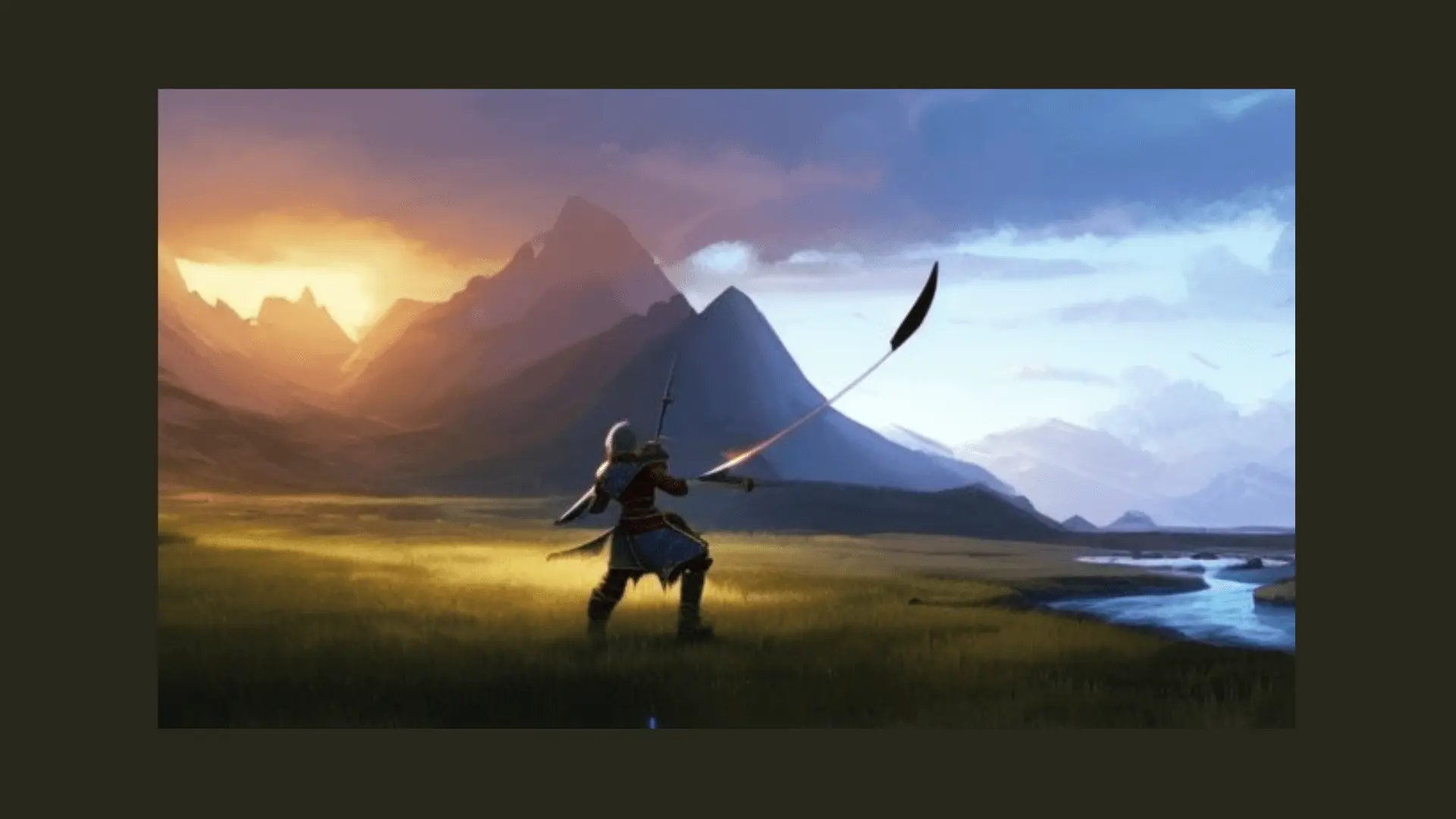Dungeons & Dragons 5th Edition (5e) features a wide variety of weapons that adventurers can use to defeat monsters and complete quests. One of the most iconic and versatile weapons in the game is the Longbow, a powerful ranged weapon that can strike enemies from afar with deadly accuracy. This longbow 5e guide will explore the Longbow in detail, including its history, advantages and disadvantages, strategies and tactics, advanced techniques, and roleplaying opportunities.
The Longbow has a rich history in real-world medieval warfare, where it was a prized weapon among archers for its range, power, and accuracy. In 5e, the Longbow is similarly revered for its ability to deal significant damage from a safe distance. It’s a versatile weapon that can be used to snipe targets from afar or provide cover fire for allies in close combat. The Longbow is also a favored weapon for many classes and subclasses, making it a popular choice for a wide range of character builds.
In this guide, we’ll discuss the key characteristics of the Longbow, including its advantages and disadvantages compared to other ranged weapons. We’ll also cover various strategies and tactics for using the Longbow in combat, including basic techniques, advanced maneuvers, and creative combos with spells and feats.
Finally, we’ll explore the roleplaying and storytelling opportunities that come with playing a Longbow user, including the character’s personality traits, motivations, and interactions with NPCs and factions.
Whether you’re a seasoned adventurer or a newcomer to the world of Dungeons & Dragons, this guide will provide valuable insights and tips for mastering the Longbow and becoming a deadly force on the battlefield. So, let’s dive into the history and characteristics of this iconic weapon!
What is a 5e Longbow?
The Longbow is a type of bow that’s characterized by its length and shape. It’s typically made from a single piece of wood or composite materials, and it can be over six feet long in some cases.
The Longbow was first used in medieval England, where it became a staple weapon of the English army during the Hundred Years’ War. The Longbow was prized for its long range and accuracy, which allowed English archers to decimate enemy forces from a safe distance.
In 5e, the Longbow is a ranged weapon that deals piercing damage. It has a range of 150/600 feet, which means it can be used to attack targets up to 150 feet away without disadvantage. Beyond that range, attacks are made with disadvantage, but the Longbow can still hit targets up to 600 feet away.
The Longbow requires two hands to use, and it has the ammunition property, which means it requires arrows to fire. Each Longbow shot requires one arrow, and the Longbow can hold up to 20 arrows at a time.
Compared to other ranged weapons in 5e, the Longbow is one of the most powerful and versatile options available. It deals more damage than most other ranged weapons, including the Shortbow and the Crossbow.
It also has a longer range than most other ranged weapons, which makes it an ideal choice for sniping targets from afar. However, the Longbow has some disadvantages that should be considered before choosing it as your primary weapon.
Advantages and Disadvantages of Using a Longbow
Before you start building a Longbow user, it’s important to understand the advantages and disadvantages of using a Longbow compared to other ranged weapons. Here are some of the key factors to consider:
Advantages:
Range and accuracy:
The Longbow has one of the longest ranges of any ranged weapon in the game, allowing you to attack enemies from a safe distance. It’s also highly accurate, which can make it easier to hit your targets.
Damage potential:
With the right equipment and stats, the Longbow can deal a significant amount of damage. This can make it a formidable weapon against even the toughest enemies.
Stealth and mobility:
Because the Longbow is a ranged weapon, it allows you to attack enemies from a distance without getting too close. This can make it easier to remain hidden and maneuver on the battlefield.
Availability and cost:
The Longbow is a relatively common weapon that can be found or purchased in most cities and towns. It’s also relatively affordable, especially compared to more exotic or specialized weapons.
Disadvantages:
Loading and ammunition requirements:
The Longbow requires arrows to use, which can be expensive and time-consuming to acquire. Additionally, the Longbow requires a free hand to load, which can limit your mobility and make it more difficult to use in close combat.
Strength and proficiency requirements:
The Longbow requires a certain amount of strength to use effectively, which can make it difficult for characters with lower strength stats. Additionally, it requires proficiency in the weapon to use effectively, which can limit the number of characters who can use it.
Close combat weaknesses:
Because the Longbow is a ranged weapon, it’s not ideal for close combat situations. If an enemy gets too close, you may be forced to switch to a different weapon or rely on other abilities to defend yourself.
Building a Longbow 5e User
In Dungeons and Dragons 5th edition, the Longbow is a powerful and versatile ranged weapon that can be an excellent choice for characters who prefer to attack from a distance. If you’re interested in building a Longbow user for your next campaign, here are some tips and strategies to consider.
Choosing a Race and Class
The first step in building a Longbow user is to choose a race and class that complements the weapon’s strengths and weaknesses. Races that offer bonuses to Dexterity or Strength can be especially effective, as these stats are crucial for using the Longbow effectively.
Classes like the Ranger or Fighter are also strong choices, as they offer bonuses to ranged attacks and can specialize in using the Longbow.
Investing in Stats and Feats
Once you’ve chosen your race and class, it’s important to invest in the right stats and feats to make the most of your Longbow. Dexterity and Strength should be your primary stats, as they determine your attack bonus and damage with the weapon.
Additionally, consider taking feats like Sharpshooter or Crossbow Expert, which can provide bonuses to attack and damage, as well as other useful abilities like ignoring cover or making additional attacks.
Acquiring the Right Equipment
To use the Longbow effectively, you’ll need to acquire the right equipment, including arrows and a quiver to hold them. Consider investing in higher-quality arrows or specialized ammunition to maximize your damage potential. Additionally, consider acquiring other equipment like a cloak of elvenkind or boots of speed, which can provide bonuses to stealth and mobility, two key strengths of the Longbow.
Mastering Techniques and Strategies
Finally, mastering the techniques and strategies for using the Longbow is crucial for success on the battlefield. Consider practicing with the weapon to improve your accuracy and speed, and experiment with different strategies like sniping, cover fire, and movement to find the most effective approach for different encounters.
Strategies and Tactics for Using a Longbow
The Longbow is a powerful weapon in Dungeons and Dragons 5th edition, but to use it effectively, you’ll need to master a variety of strategies and tactics. Here are some of the key techniques and considerations to keep in mind when using a Longbow in combat.
Basic Longbow Techniques
The first step in using a Longbow effectively is to master the basic techniques of aiming, shooting, and reloading. This involves learning how to properly hold the bow, nock the arrow, draw the bowstring, and release the arrow.
Practice these techniques to improve your accuracy and speed, and consider investing in feats or equipment that can enhance your abilities, such as the Sharpshooter feat or a quiver of specialized arrows.
Positioning and Movement in Combat
Positioning and movement are crucial considerations when using a Longbow. The Longbow is most effective when used from a distance, so positioning yourself behind cover or in a vantage point can be a key advantage. Additionally, consider moving around the battlefield to gain different angles on your targets or to avoid incoming attacks.
Terrain and Weather Considerations
Terrain and weather can have a significant impact on the effectiveness of the Longbow. Consider the range of the weapon and the terrain of the battlefield when choosing your position. Additionally, keep in mind how weather conditions like wind, rain, or snow can affect your accuracy and adjust your strategy accordingly.
Target Prioritization and Threat Assessment
When using a Longbow, it’s important to prioritize your targets based on their threat level and vulnerability. Consider targeting enemies that pose the most immediate danger to you or your party members, or those that are weak to ranged attacks.
Be aware of any obstacles or defenses that your targets may have, such as cover or spells, and adjust your strategy accordingly.
Cooperation with Party Members
Finally, cooperation with your party members can be crucial for success when using a Longbow. Consider coordinating your attacks with other ranged or melee attackers, or using your Longbow to provide cover or support for your allies. Additionally, communicate with your party members to coordinate your movements and avoid friendly fire.
| Tactic | Description |
| Sniping | Attacking enemies from a distance to avoid retaliation |
| Cover fire | Providing support to allies by attacking enemies or forcing them into cover |
| Movement | Moving around the battlefield to gain different angles or avoid attacks |
| Target prioritization | Prioritizing high-threat or vulnerable enemies |
| Cooperation with party members | Coordinating attacks and movements with other party members |
Advanced Techniques and Combos
Once you’ve mastered the basic techniques of using a Longbow, there are a variety of advanced techniques and combos that can take your combat abilities to the next level. Here are some of the key techniques and considerations to keep in mind when using a Longbow in more advanced situations.
Multiclassing and Synergy with Other Abilities
One way to enhance your Longbow abilities is to multiclass with other classes or to take feats or abilities that complement your Longbow skills. For example, multiclassing as a Ranger or Rogue can give you additional ranged combat abilities, while taking the Crossbow Expert feat can allow you to make more attacks with your Longbow.
Feat Combinations and Special Maneuvers
Another way to enhance your Longbow abilities is to combine feats or use special maneuvers that can give you an edge in combat. For example, combining the Sharpshooter feat with the Hunter’s Mark spell can significantly increase your damage potential, while using the Volley maneuver can allow you to attack multiple targets at once.
Creative Use of Spells and Items
Using spells and items creatively can also enhance your Longbow abilities. For example, casting Fog Cloud can provide cover for you and your allies, while using a Bag of Holding to store extra ammunition can allow you to keep fighting for longer periods of time.
Roleplaying Opportunities and Character Development
Finally, using a Longbow in creative and unique ways can provide opportunities for roleplaying and character development. Consider developing a backstory that explains why your character prefers ranged combat or using your Longbow to solve puzzles or overcome obstacles in non-combat situations.
Common Longbow Builds and Variations
There are many different ways to build a Longbow character in D&D 5e, depending on your preferred play style and character concept. Here are some of the most common Longbow builds and variations you may encounter.
Sniper
The Sniper build is focused on dealing massive damage from long range. This build typically involves taking feats like Sharpshooter and taking advantage of the Longbow’s long range and high damage potential to take out enemies before they can get close.
Archer
The Archer build is a more versatile version of the Sniper, focusing on dealing damage from a distance but also having the ability to engage in close combat if needed. This build often involves taking feats like Crossbow Expert and combining the Longbow with other ranged weapons like a Shortbow or a Hand Crossbow.
Scout
The Scout build is all about mobility and positioning. This build typically involves taking levels in classes like Ranger or Rogue to gain additional movement and stealth abilities, allowing the character to move quickly and stay hidden while sniping enemies from a distance.
Hybrid Builds
Hybrid builds combine the Longbow with other classes or abilities to create unique character concepts. For example, a Longbow/Wizard build might combine the Longbow’s ranged capabilities with powerful spells like Fireball, while a Longbow/Rogue build might focus on using the Longbow to deal sneak attack damage.
Non-Standard Variations
Finally, there are a variety of non-standard variations on the Longbow that can add unique twists to your character concept. For example, an enchanted Longbow might have special abilities like the ability to shoot magical arrows or to fire faster than a normal Longbow, while an oversized Longbow might deal more damage but require more strength to use effectively.
Roleplaying and Storytelling with a Longbow User
Using a Longbow in D&D isn’t just about combat mechanics – it’s also an opportunity to explore rich storytelling and roleplaying elements. Here are some aspects of roleplaying and storytelling that can make playing a Longbow user a rewarding experience.
History and Culture of Longbow Use
The Longbow has a rich history and cultural significance in fantasy settings, which can be woven into your character’s backstory and roleplaying. For example, your Longbow user might come from a tribe of skilled archers, or might have been trained in a prestigious academy of Longbow users. Exploring the cultural and historical aspects of Longbow use can add depth and richness to your character’s story.
Personality Traits and Motivations
Like any character in D&D, a Longbow user should have their own unique personality traits and motivations that drive them. Are they a lone wolf, preferring to work alone and stay hidden? Or are they a charismatic leader, inspiring others with their bow skills? Exploring your character’s personality and motivations can help bring them to life and make them more memorable.
Interactions with NPCs and Factions
As a Longbow user, your character is likely to interact with a variety of NPCs and factions throughout your adventures. How do they view Longbow users? Are they revered for their skill and accuracy, or are they seen as cold and distant? Building relationships with NPCs and factions can add depth and nuance to your character’s story.
Quests and Adventures Suited for Longbow Users
Finally, there are a variety of quests and adventures that are particularly well-suited for Longbow users. For example, a quest might require the player to track and take down a particularly elusive target from afar, or might involve defending a castle or town from a distant enemy army.
By seeking out quests and adventures that showcase the Longbow’s unique capabilities, you can fully explore the potential of your character’s abilities and build a truly memorable story.
FAQS
What is the bonus for Longbow in 5e?
The bonus for Longbow in 5e is based on a character’s proficiency bonus and their Dexterity modifier. A character adds their proficiency bonus to attack rolls made with the Longbow if they are proficient with it, and they add their Dexterity modifier to the attack roll and to the damage roll if the attack hits.
Do you add Dex to Longbow damage?
Yes, a character adds their Dexterity modifier to the damage roll for a Longbow if the attack hits. However, the damage dice for a Longbow are not affected by a character’s Dexterity modifier.
How does Longbow range work in 5e?
Longbow range in 5e is determined by its maximum range and its short range. The maximum range for a Longbow is 600 feet, which means that a character can make an attack with a Longbow at any target within 600 feet. The short range for a Longbow is 150 feet, which means that attacks made with a Longbow beyond 150 feet are made with disadvantage.
Do you use Strength or Dex for Longbow?
A character primarily uses their Dexterity score for the Longbow, as it is a ranged weapon that requires precision and accuracy. However, a character must also have a Strength score of at least 13 to use the Longbow without penalty. If a character does not meet this requirement, they have disadvantage on attack rolls made with the Longbow.
Is Horn Bow better than Longbow?
Horn Bow and Longbow are both martial ranged weapons in 5e with their own unique properties and advantages. While Horn Bow has a faster loading time than Longbow, it has a shorter range and a lower damage potential.
Longbow, on the other hand, has a longer range and a higher damage potential but requires more time to load. The effectiveness of Horn Bow or Longbow depends on the specific situation and the character’s preferences.
Is the Longbow a good sniper?
The Longbow can be an effective weapon for sniping in 5e. Especially in outdoor settings where the long range of the weapon can be fully utilized. With a maximum range of 600 feet, the Longbow can take down enemies from a safe distance, allowing the user to stay hidden and out of harm’s way.
Longbow users can take advantage of the Stealth and Perception skills to move quietly and avoid detection. While scouting and taking out targets from a distance. However, the effectiveness of the Longbow as a sniper weapon also depends on the specific character build and their proficiency in using the weapon.









